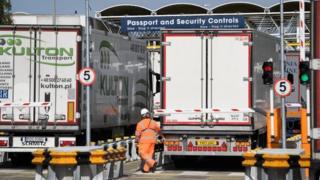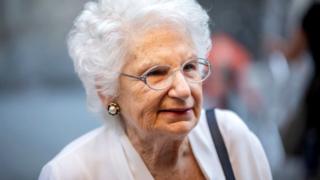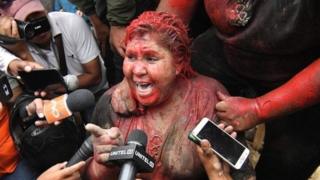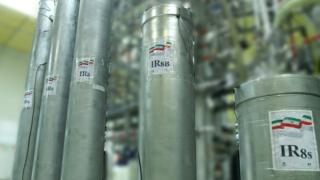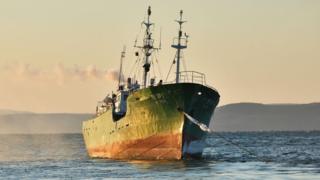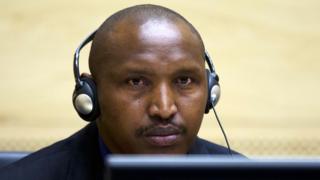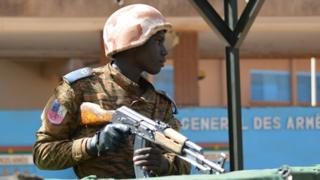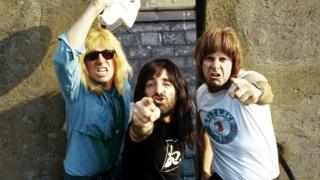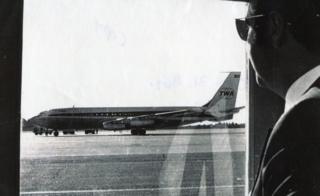 Image copyright
Image copyright
Bangor Daily News
Airline official Norman Kaye looks out at hijacked TWA85 at Bangor airport, Maine

At the high point of the 1960s spate of hijackings, a plane was held up on average once every six days in the United States. Fifty years ago this week, Raffaele Minichiello was responsible for the “longest and most spectacular” of them, as one report described it at the time. Could those on board ever forgive him?
21 August 1962
Under the hills of southern Italy, a little north-east of Naples, a fault ruptured and the earth began shaking. Those living on the surface, in one of the most earthquake-prone parts of Europe, were used to this. The 6.1-magnitude quake in the early evening was enough to frighten everyone, but it was the two powerful aftershocks that did the most damage.
Twenty kilometres up from the epicentre and a few hundred metres north was where the Minichiello family lived, including 12-year-old Raffaele. By the time the third earthquake had subsided, their village of Melito Irpino was uninhabitable. The Minichiello family were left with nothing, Raffaele would later recall, and no-one in authority came to help.
The damage was such that almost the entire village was evacuated, razed and rebuilt. Many families would return, but the Minichiellos decided to move to the US for a better life.
What Raffaele Minichiello found instead was war, trauma and notoriety.
01:30; 31 October 1969
Dressed in camouflage, Raffaele Minichiello stepped on to the plane, a $15.50 ticket from Los Angeles to San Francisco in his hand.
This was the last stop on Trans World Airlines flight 85’s journey across the US, which had started several hours earlier in Baltimore before calling at St Louis and Kansas City.
The crew of three in the cockpit were helped by four young female flight attendants, most of whom had been in the job for only a few months. The most experienced was Charlene Delmonico, a bob-haired 23-year-old from Missouri who had been flying with the airline for three years. Delmonico had swapped shifts to fly on TWA85 as she wanted Halloween night free.
Before leaving Kansas City, captain Donald Cook, 31, had informed the flight attendants of a change in the usual practice: if they wanted to enter the cockpit, they were to ring a bell outside the door, and not knock.
The flight landed in Los Angeles late at night. Passengers disembarked and others, bleary-eyed, joined the short night flight to San Francisco. The lights were dimmed so that those who had stayed on board could continue sleeping. The flight attendants checked the passengers’ tickets when they boarded quietly, but Delmonico paid particular attention to one of the new arrivals, especially his bag.
The tanned young man in camouflage, his wavy brown hair flattened, was nervous but polite as he boarded. A thin container protruded from his backpack.
Delmonico moved towards the first-class compartment, where her colleagues Tanya Novacoff and Roberta Johnson were guiding passengers to their seats. “What was that thing sticking out of the young man’s backpack?” Delmonico asked them. The answer – a fishing rod – calmed her fears and she returned to the back of the plane.
Image copyright
Getty Images
TWA85, one of the notoriously noisy Boeing 707 fleet, during the hijacking
The flight was far from busy. With only 40 passengers on board, there was room for everyone to spread out and seek their own row in which to sleep.
Among them were the five mop-topped members of the sunshine pop group Harpers Bizarre, exhausted after a strange concert in Pasadena that night that had been temporarily halted by a man screaming from the balcony of the auditorium. It had been two years since the band’s biggest hit, an adaptation of Simon & Garfunkel’s The 59th Street Bridge Song (Feelin’ Groovy), but they would hit the peak of their fame just a few hours later.
Singer-guitarist Dick Scoppettone and drummer John Petersen settled on the left-hand side of the plane and, relaxing into their seats, they lit cigarettes. At 01:30 on Friday, 31 October 1969, TWA flight 85 left Los Angeles for San Francisco. Fifteen minutes into the flight, the hijack began.
Anyone sleeping peacefully would have had their rest disturbed on take-off. To boost the plane’s thrust, the Boeing 707 injected water into the engines as it took off, earning it the industry nickname the Water Wagon. The effect inside the plane was violent and noisy, producing an ominous deep rumble.
Darkness fell inside the plane as the flight attendants turned the lights almost all the way down. As silence settled, Charlene Delmonico began tidying the galley in the back of the plane with Tracey Coleman, a 21-year-old languages graduate who had joined TWA only five months earlier.
The nervous passenger in camouflage from earlier stepped into the galley and stood alongside them. He had an M1 rifle in his hand. Delmonico, calm and professional, responded simply: “You’re not supposed to have that.” He responded by handing her a 7.62mm bullet to prove the rifle was loaded, and ordered her to lead him to the cockpit to show it to the crew.
Image copyright
Getty Images
Charlene Delmonico (R) demonstrates to the press how the hijacking happened, alongside Tanya Novacoff (L) and Roberta Johnson (C)
Dick Scoppettone was drifting off to sleep but the movement further down the aisle roused him. Out of the corner of his eye he saw Delmonico being followed by a man who was pointing a rifle at her back. His bandmate John Petersen turned to him from a few rows in front and stared wide-eyed. “Is this really happening?”
Towards the back of the plane, one of the passengers, Jim Findlay, got up to confront Minichiello. The hijacker turned around. He shouted to Delmonico: “Halt!”
This man is a soldier, Delmonico thought.
With Findlay ordered back to his seat, Delmonico and Minichiello moved up the cabin again. She pushed the curtain aside to enter the first-class compartment, her knees buckling under the nerves, and alerted the two flight attendants ahead of her: “There’s a man behind me with a gun.” They both moved quickly out of the way.
Some of the passengers heard Minichiello shout at Delmonico as he became more and more agitated next to the cockpit door. For the most part he was polite, respectful and came across, in her words, as “a nice clean-cut kid”, but by now paranoia was getting the better of him.
Delmonico remembered the captain’s instruction: don’t knock to enter, ring the bell instead. But Minichiello, afraid he was being tricked, refused to let her do this. She knocked instead, and hoped this would alert the crew. The door opened, and Delmonico told the wary crew there was a man with a gun behind her. Minichiello stepped inside and pointed the rifle at each of the three men inside the cockpit: captain Cook, first officer Wenzel Williams and flight engineer Lloyd Hollrah.
Minichiello appeared to be well trained and well armed, Williams thought. He knew what he wanted from the crew, and was determined to get it. After Delmonico had stepped out of the cockpit, Minichiello turned to the crew and said in heavily accented English: “Turn towards New York.”
Image copyright
Getty Images
FBI special agent Scott Werner with the bullet handed to Charlene Delmonico
The unusual sight of a man walking through the plane with a gun had not gone unnoticed by those passengers who were still awake.
The members of Harpers Bizarre had all raced to sit next to one another within seconds of the gunman passing by. Their strange evening had just got stranger. They speculated how the man might have been able to sneak a rifle on to the plane. Where could they be going? Hong Kong, maybe? They’d never been to Hong Kong, that could be fun.
Nearby, Judi Provance’s training kicked in. An off-duty TWA flight attendant, she was returning home to San Francisco after eight days on rota flying around Asia. Every year, she and TWA staff would undertake training in how to respond during emergencies, including hijackings. The main lesson they had been taught was to stay calm. Another was to not fall in love with the hijacker – it was easy, they had been told, for hijackers to elicit sympathy from the crew.
Provance quietly mentioned to those around her that she had seen someone walking down the aisle with a gun. She had been taught not to cause panic, and to help manage the situation calmly. Jim Findlay, the man who had previously tried to intervene, was a TWA pilot “deadheading” on board as a passenger. He found the hijacker’s bags and went through them to look for clues to his identity, and to make sure no more weapons were on board. Only later did the passengers find rifle magazines full of bullets.
Captain Cook’s voice came over the loudspeaker. “We have a very nervous young man up here and we are going to take him wherever he wants to go.”
As the flight moved further and further from San Francisco, other messages were communicated to the passengers, or started spreading among them: they were heading to Italy, Denver, Cairo, Cuba. The crew inside the cockpit feared for their lives, but some of the passengers felt they were part of an adventure. An odd one, but an adventure nevertheless.
It was only natural that people on board TWA85 thought they might be heading to Cuba. It had long been hijackers’ destination of choice.
From the early 1960s, a number of Americans disillusioned with their homeland and entranced by the promise of a communist ideal had fled to Cuba following Fidel Castro’s revolution. As American planes did not normally fly to the island, hijacking gave people the means of getting there. And by accepting hijackers from the US, Castro could embarrass and annoy his enemy while demanding money to return the planes.
A three-month period in 1961 heralded the start of the hijacking phenomenon. On 1 May, Antulio Ramirez Ortiz boarded a National Airlines flight from Miami under a false name, and seized control of the plane by threatening the captain with a steak knife. He demanded to be flown to Cuba, where he wanted to warn Castro of a plot to kill him that had been wholly imagined by Ramirez.
Media playback is unsupported on your device
Two more hijackings followed over the following two months, and the next 11 years saw 159 commercial flights hijacked in the United States, Brendan I Koerner writes in his book The Skies Belong To Us: Love and Terror in the Golden Age of Hijacking.
Hijackings that ended in Cuba were so common, he writes, that at one point US airline captains were given maps of the Caribbean and Spanish-language guides in case they had to unexpectedly fly to Havana. A direct phone line was set up between Florida air traffic controllers and Cuba. And there was even a suggestion that a replica of Havana’s airport be built in Florida, to fool hijackers into thinking they had reached Cuba.
The hijackings were able to happen because of a lack of security at airports. There was simply no need to check passengers’ luggage because no-one had ever caused any trouble, until the hijackings began. For years after that, the airline industry resisted introducing checks because they feared it would ruin the passenger experience and slow down the check-in process.
“We lived in a different world,” Jon Proctor, a gate agent with TWA at Los Angeles International Airport in the 1960s, told the BBC. “People didn’t blow up airliners. If anything, they might hijack an airliner and want to go to Cuba, but they didn’t try to blow up an airliner.”
It would later emerge that Raffaele Minichiello had disassembled his rifle and carried it on to TWA85 in a tube, before putting the gun back together in the plane’s bathroom. Taking it on board would have been “very easy”, Proctor says. Gate agents would only have weighed his backpack and not checked it.
By the time TWA85 was held up, there had already been 54 hijackings in the US in 1969, the Associated Press reported at the time, at a rate of one every six days. But no-one had ever hijacked a plane in the US and taken it to another continent.
The crew were getting mixed messages from their jittery passenger: he wanted to go to New York, or maybe Rome. If their destination was to be New York, that would be a problem: they had enough fuel to fly only to San Francisco, so would have to stop for more. And if they were heading for Rome, there would be an even bigger obstacle: nobody on board was qualified to fly internationally.
Eventually, captain Cook was allowed into the cabin to talk to the passengers. “If you’ve made any plans in San Francisco,” he said, “don’t plan on keeping them. Because you’re going to New York.”
After some negotiation, Minichiello agreed to let the captain land in Denver to take on enough fuel to reach the east coast. While over Colorado, Cook alerted air traffic control for the first time that the plane had been hijacked.
The plans soon changed: Minichiello would let the 39 other passengers get off in Denver, but he insisted that one of the flight attendants stay on board. A small debate broke out about who should stay. The hijacker’s preference was Delmonico, whom he had led to the cockpit at gunpoint. Cook wanted Roberta Johnson, whom he knew best of all four attendants.
As Delmonico began writing a manifest of all passengers on board, Tracey Coleman went up to the cockpit with coffee for the crew. When she stepped back out, she insisted to Delmonico: “I’m gonna go.” Coleman had a boyfriend in New York, she said, and could go and see him. But Delmonico knew New York would not be the final destination. “You’re not going to stay in New York,” she told Coleman. “He can’t stay there, he’ll be arrested if he gets out there. He’s going somewhere else – I don’t know where, but he’s going somewhere else.”
Coleman, in an interview with TWA Skyliner magazine after the hijacking, said she knew what was at stake. “It wasn’t because I just wanted to go along for the ride,” she said. “But it was feared that if one of the stewardesses didn’t stay aboard, he may not let the passengers off in Denver.”
Minichiello had demanded that the lights at Denver’s Stapleton International Airport be turned off as the plane landed. He didn’t want any surprises, and promised to release the passengers only if there was no trouble.
His nerves apparently calming, the hijacker proved unexpectedly accommodating. While he was exiting, Jim Findlay, the deadheading TWA pilot, realised he had left behind a Halloween outfit he had bought in Hong Kong. Findlay asked Minichiello if he could return to the back of the plane to retrieve it. He politely replied: “Sure.”
As the passengers filed off the plane in cold, foggy weather with sunrise still two hours away, they were met by an unsmiling FBI agent in an overcoat. The relief among those allowed to leave was clear, and they were led down a darkened corridor through the terminal. At the end was a room swarming with FBI agents, who had rushed to the airport at short notice and were waiting to take statements from the 39 passengers and three flight attendants.
Image copyright
Denver Post/Getty Images
Harpers Bizarre, pictured at Denver airport after the hijacking, said it was their best publicity ever
The members of Harpers Bizarre remembered what their manager had once told them: if they were ever involved in any trouble, anything at all, they were to call him first, even before they got to a police station or hospital. As soon as they reached the terminal, they did just that, even though it was the middle of the night where he lived.
The tactic paid off. When they had finished giving their statements, they stepped into another room and were greeted by the flash of camera bulbs, reporters shouting the band’s name, and phones ringing as news outlets around the US hoped to hear their story. “It was the best publicity we ever had, by a mile,” Dick Scoppettone told the BBC.
The assembled photographers captured tired passengers slumped against walls. Other passengers smiled, bemused, as they recounted what had happened. The three flight attendants gave statements to the FBI, and Charlene Delmonico’s ran to 13 handwritten pages.
After a day of interviews, all the flight attendants got home to Kansas City late in the evening, as TV channels kept viewers updated as the unlikely hijack continued.
Delmonico settled in at home after more than a day without sleep. Late in the evening, her telephone rang. It was the FBI, could they come around to see her? They arrived at 23:00 and handed her a photo. The image of Raffaele Minichiello looked back at her. “Yes, that’s him,” she said.
It was a face she would encounter again almost 40 years later.
The three-hour flight from Denver passed peacefully. Minichiello, stretched out in first class with the gun at his side, had calmed down. He poured himself an unusual cocktail from two miniature bottles – Canadian Club whisky and gin. Only five people remained on board TWA85 – captain Cook, first officer Wenzel Williams, flight engineer Lloyd Hollrah, flight attendant Tracey Coleman and the hijacker himself.
The plane landed at John F Kennedy airport late in the morning, and was parked as far from the terminals as possible. The order from the cockpit, like in Denver, was for as few people as possible to approach the plane. But the FBI was ready, and keen to stop the hijacker before he set a dangerous precedent and took a domestic flight to another continent. Close to 100 agents were waiting for TWA85, many disguised as mechanics hoping to sneak on board.
Within minutes of the landing, as refuelling was about to take place, the FBI started approaching the plane. Through the cockpit window, Cook spoke to one agent who wanted a reluctant Minichiello to come closer to the window to speak to them.
“Raffaele was running up and down the aisles to make sure they weren’t trying to sneak in the airplane,” Wenzel Williams told the BBC 50 years on. “He felt he would be shot if he came to the window.”
The captain, one eye on his passenger, warned the agents to stay away from the plane. Soon afterwards, a shot rang out.
Image copyright
Bangor Daily News
TWA85 later in the journey, with its new captain on board
The accepted version of events now is that Minichiello did not intend to shoot. In his agitated state, just outside the cockpit door, he is thought to have nudged the trigger of his rifle with his finger. The bullet pierced the ceiling and glanced off an oxygen tank, but did not penetrate it or the plane’s fuselage. Had it damaged the fuselage, the plane would not have been able to fly on. Had it pierced the oxygen tank and caused an explosion, there might not have been a plane, or crew, left to fly.
Even though the shot had apparently been fired by accident, it sent shivers through the crew and they were reminded that their lives were at stake. Captain Cook – who was sure the rifle had been fired on purpose – shouted at the agents through the window, chastising them and telling them the plane was leaving immediately, without refuelling.
Two TWA captains of 24 years’ experience who were allowed to fly internationally, Billy Williams and Richard Hastings, pushed their way through the FBI agents and onto the plane. Everyone else stayed on board.
“The FBI plan was damned near a prescription for getting the entire crew killed,” Cook later told the New York Times.
“We sat with that boy for six hours and had seen him go from practically a raving maniac to a fairly complacent and intelligent young man with a sense of humour, and then these idiots… irresponsibly made up their own minds about how to handle this boy on the basis of no information, and the good faith we had built up for almost six hours was completely destroyed.”
The two new pilots, who were in no mood to humour the hijacker, took charge of the plane. Minichiello ordered everyone else to stay inside the cockpit with their hands on their heads.
The plane took off quickly, with nowhere near enough fuel on board to reach its intended destination: Rome.
Twenty minutes after the plane had left New York with a bullet lodged in its roof, the tension on board had eased, thanks largely to Cook convincing Minichiello that the crew had nothing to do with the chaos at Kennedy airport.
The events there meant the plane had been unable to refuel, so within the hour, TWA85 landed in the north-eastern corner of the US in Bangor, Maine, where it took on enough fuel to cross the Atlantic. By now, in the early afternoon, the story of the hijacking and the drama in New York had gained the full attention of the American media. Photographers and reporters turned out en masse at Bangor’s airport terminal.
Close to 75 police officers ensured the press stayed as far as possible from the plane in case the gunman was provoked again. Hundreds of people had driven to the airport to get a glimpse of the action, but were kept half a mile away from the terminal. From the plane, the hijacker spotted two people watching from a nearby building. Cook, eager to leave, radioed the control tower: “You had better hurry. He says he is going to start shooting at that building unless they get a move on.” The two men quickly left.
On board, as the plane headed towards international airspace, a sense of solidarity had begun to develop among those who had been together for more than nine hours. But under the surface, even as they tried to keep the hijacker happy, the crew continued to fear for their lives.
With the new pilots on board, Cook went to sit with Minichiello in the first-class compartment, where they swapped stories. Cook spoke of his time as an air traffic controller with the US Air Force. The rifle rested between them, but at no point did the crew try to take it, mostly out of concern over how the hijacker might react.
Minichiello repeatedly asked Cook if he was married. He replied that he was, despite being a bachelor. “That seemed wiser,” Cook told the New York Times later. He had assumed a jittery man with a gun would be less likely to harm married crew. “He asked how many kids I had and I said one. Then he asked about the other members of the crew and I said: ‘Yeah, all of them are married.'” In fact, only one of the four original crew members was married.
Tracey Coleman, too, spent time chatting to Minichiello during the transatlantic trip, the first time she had left the United States or flown for longer than four hours. He taught her card games including solitaire and he was “a very easy fellow to talk to”, she would later recall. He talked about his family moving to the US and, intriguingly, said he had “had a little military trouble after coming back to the States and just wanted to go home to Italy”, Coleman later told an airline industry magazine.
She slept a little during the six-hour flight from Bangor to Shannon, on Ireland’s west coast, where TWA85 refuelled once more in the middle of the night. Few others on board were able to sleep. “We were too keyed up for that,” Wenzel Williams recalled. The only food on board was a handful of cupcakes left on the original flight from Kansas City to Los Angeles. “Food wasn’t exactly much of an issue,” Williams told the BBC. “Having a gun pointed at us a good bit of the time kept most other issues at bay.”
As TWA85 crossed time zones on its approach to Ireland, and 31 October became 1 November, Minichiello turned 20. No-one celebrated.
Half an hour after landing in Ireland, TWA85 was off again, on the final stretch of its 6,900-mile (11,000km) journey to Rome.
TWA85 circled Rome’s Fiumicino airport early in the morning. Minichiello had one more demand: the plane was to be parked far from the terminal and he was to be met by an unarmed police official. The hijack was nearing its end, 18-and-a-half hours after it had started over the skies of central California. It was, the New York Times reported at the time, “the world’s longest and most spectacular hijacking”.
In the last few minutes of the flight, Williams said, the hijacker offered to drive the crew to a hotel once they had landed, an offer they politely declined. Minichiello also feared the crew would be punished for not having stolen his gun when they had the opportunity. “I’ve given you guys an awful lot of trouble,” he told Cook. “That’s all right,” the captain replied. “We don’t take it personally.”
At the airport, shortly after 05:00, a lone Alfa Romeo approached the plane. Out of it emerged Pietro Guli, a deputy customs official who had volunteered to meet the hijacker. He walked up the steps to the plane with his hands up, and Minichiello emerged to meet him.
“So long, Don,” the hijacker told the captain as he left. “I’m sorry I caused you all this trouble.” Minichiello noted Cook’s address in Kansas City so he could later write to him and explain what had happened after they separated.
The two men walked down the steps towards the car, Minichiello still holding his rifle, and the six people on board felt “total relief”, according to first officer Wenzel Williams. They were free again. But they all hoped the next stage of the hijacking would end safely, for both Minichiello and his new hostage.
After Los Angeles, Denver, New York, Bangor, Shannon and Rome, there was only one destination now. “Take me to Naples,” Minichiello ordered Pietro Guli. He was heading home.
Four police cars trailed the Alfa Romeo and the officers’ voices crackled over the hostage’s radio. Minichiello, sitting in the back seat, switched off the radio and gave his hostage directions where to go.
Image copyright
AFP/Getty Images
Police searched the countryside outside Rome for Raffaele Minichiello, with little luck
In the countryside about six miles from the centre of Rome, having somehow evaded the pursuing cars, the Alfa Romeo travelled down lanes that became ever more narrow. Eventually it reached a dead end and both men stepped out of the car. Realising he had few options left, Minichiello sprinted away in panic.
Twenty-three hours after TWA85 left Los Angeles, Minichiello’s journey came to an end. It did so only because of the publicity the hijacking had generated. Over five hours in the hills around Rome, hundreds of police officers, some with dogs and helicopters, led the search for the hijacker. But in the end, he was found by a priest.
Saturday, 1 November was All Saints Day, and the Sanctuary of Divine Love was full for morning Mass. Among the well-dressed congregation, the young man in his vest and undershorts stood out. Minichiello had sought shelter in the church after shedding his military clothes and stashing his gun in a barn. But his face was now famous and the vice-rector, Don Pasquale Silla, recognised him.
When the police finally surrounded Minichiello outside the church, he expressed bemusement – interpreted by reporters as the arrogance of a young criminal – that his countrymen might want to detain him. “Paisà [my people], why are you arresting me?” he asked.
Image copyright
AFP/Getty Images
Minichiello under arrest in Rome: “What plane? I don’t know what you’re talking about”
He employed the same tone hours later while speaking to reporters, his hands free of cuffs, after a brief interrogation in a Rome police station. “Why did you do it?” one reporter asked. “Why did I do it?” he replied. “I don’t know.” When another asked him about the hijacked plane, he replied in a perplexed tone: “What plane? I don’t know what you’re talking about.”
But in another interview, he revealed the real reasons for the hijack.
As the news of Minichiello’s arrest spread around the world later that day, Otis Turner sat down for breakfast in the mess of his Marine barracks in California.
The television in the corner was relaying the details of the daring hijack and the manhunt in the Italian countryside. “Then they flashed up Raffaele’s picture,” Turner told the BBC. “I was just floored, absolutely floored.”
The two men had served in the same platoon in Vietnam and become close friends before being separated in the US. “I was confused at first,” Turner said, “but when I really got to thinking about it, I knew he had had some issues and it all came together.”
When the hijacking happened, it was four-and-a-half years since US combat forces had first landed in Vietnam and the fall of Saigon was still more than five years away. The US would leave Vietnam having completely failed in its mission, leaving more than 58,000 American service personnel and millions of Vietnamese – both combatants and civilians – dead.
Opposition in the US to the war was at its peak in late 1969. An estimated two million people across the US had taken part in the Moratorium to End the War in Vietnam – reported as the biggest demonstration in American history – two weeks before the hijacking.
The lottery drafting young Americans to fight was still a month away from being enforced, but many thousands of young men had already volunteered, believing back then that the cause – to fight the communists of North Vietnam – was valid. Raffaele Minichiello was one of those who volunteered.
Image copyright
Raffaele Minichiello
Raffaele Minichiello in Vietnam
In May 1967, the 17 year old left his home in Seattle, to where he and his family had moved after the earthquake in their Italian homeland in 1962. He travelled to San Diego to enlist in the Marine Corps, and for those who knew him – a little stubborn, a little gung-ho – this did not come as a surprise.
Minichiello barely spoke English, and had been teased for his thick Neapolitan accent by his classmates before dropping out of school altogether. Doing so had brought an end to his ambitions of being a commercial pilot. But he was proud of his adopted country, and was willing to fight for it in the hope it would make him a naturalised American citizen.
Otis Turner arrived in Vietnam at about the same time as Minichiello, and they served in different squads in the same Marine platoon. They were “grunts” – the men dropped on to the jungle-cloaked hills of the front line for a few months at a time to take the fight to the communist forces.
“Anybody will tell you: the grunts had the toughest job in the Marine Corps,” Turner, now living in Iowa, said. “We were in 120-degree (49C) weather, in monsoon season. It was terrible. We saw the worst of the worst.”
In 2019, Turner looks back with some shame at what they were ordered to do, and how they complied. Their mission was brutally simple: they were to enter villages and towns and kill the enemy. “From the time we joined the Marine Corps, we were basically all about kill, kill, kill,” he said. “That’s all they wanted us to do. They drilled that into us from the beginning.”
Of those serving on the front line, Minichiello was often the one leading the charge. Doing so brought him into firefights that killed close friends, and led him to save others who were in danger. He was awarded the Cross of Gallantry, which was given out by the government of South Vietnam to those who had displayed heroic conduct in the war.
The men had come to know only one mode – they were Marines, born to fight – and adjusting to daily life proved impossible. “There was no staging area to regroup or to get your mind and body back working as one unit,” Turner told the BBC. “There was no period there just to break it all down and think about what you had just done, to see a professional.
“There were a lot of sick people, confused people. Raffaele was in some state. All of us were confused when we left Vietnam.”
Turner says most members of his and Minichiello’s platoon – including himself – went on to be diagnosed with post-traumatic stress disorder (PTSD). The US Department of Veterans Affairs estimates that up to 30% of all those who served in Vietnam have suffered PTSD at some point in their lives – about 810,000 people.
Raffaele Minichiello would not be diagnosed until 2008.
Tracked down by reporters near Naples, Minichiello’s father – who was by then suffering from terminal cancer and had returned to Italy – knew immediately what had caused his son to hijack the plane. “The war must have provoked a state of shock in his mind,” Luigi Minichiello said. “Before that, he was always sane.” He vowed to clip him around the ear when he next saw him.
Image copyright
Alamy
Maria Minichiello, Raffaele’s mother, cries outside court in Rome, to where she had travelled from the US
Another reason for the hijacking soon emerged. While in Vietnam, Minichiello had been sending money to a Marines savings fund. He had collected $800, but when he returned to base in Camp Pendleton, California, he noticed there was only $600 in his account. It was not enough to pay for a visit to Italy to see his dying father.
Minichiello raised his concerns with his superiors, and insisted he be given the $200 he felt he was owed. His superiors didn’t listen, and dismissed his complaint. And so Minichiello took matters into his own hands, albeit clumsily. One night, he broke into the store on the base to steal $200 of goods. Unfortunately for him, he did so after drinking eight beers and fell asleep inside the store. He was caught the next morning.
The day before he hijacked TWA85, he had been due to appear before a court martial in Camp Pendleton but, fearing prison, he went awol and travelled up to Los Angeles. With him, he took a Chinese rifle he had registered as a war trophy in Vietnam.
Against the odds, Minichiello became a folk hero in Italy, where he was portrayed not as a troubled gunman who had threatened a planeload of passengers, but as a fresh-faced Italian boy who would do anything to return to the motherland. He faced trial in Italy – the authorities there insisted on this within hours of his arrest – and would not face extradition to the US, where he could have faced the death penalty.
At his trial, his lawyer Giuseppe Sotgiu portrayed Minichiello as the poor victim – the poor Italian victim – of an unconscionable foreign war. “I am sure that Italian judges will understand and forgive an act born from a civilisation of aircraft and war violence, a civilisation which overwhelmed this uncultured peasant.”
Image copyright
AP
The promise of a nude modelling career for Minichiello came to nothing
He was prosecuted in Italy only for crimes committed in Italian airspace, and sentenced to seven-and-a-half years in prison. That sentence was quickly reduced on appeal, and he was released on 1 May 1971.
Wearing a brown suit, the 21 year old stepped out of the Queen of Heaven prison near the Vatican to face crowds of photographers and cameramen. Occasionally overawed by the attention and breaking into a smile that flitted from nervousness to cockiness, he stopped to speak to reporters. “Are you sorry for what you did?” one asked. “Why should I be?” he replied, grinning.
But after that, an array of prospects came to nothing. A nude modelling career never took off, and a promise by a film producer to turn Minichiello into a Spaghetti Western star was never kept. For years, rumours swirled that the character John Rambo was based on Minichiello – after all, Rambo was a decorated but misunderstood Vietnam veteran who had lost the plot – but the man who created Rambo has since dismissed the suggestion.
In the years after prison, Minichiello settled in Rome where he worked as a bartender. He married the bar owner’s daughter, Cinzia, with whom he had a son. At one point he also owned a pizza restaurant named Hijacking.
23 November 1980
The earthquake that had destroyed Raffaele Minichiello’s hometown in 1962 was just a precursor. Eighteen years later, a magnitude-6.9 earthquake struck southern Italy, its epicentre barely 20 miles from the one in 1962.
This was the most powerful earthquake to strike Italy in 70 years, and it caused enormous damage across the Irpinia region. Up to 4,690 people were killed and 20,000 homes – many of them in a weakened state after the 1962 quake – were destroyed.
Image copyright
Getty Images
A village that was destroyed in the 1980 Irpinia earthquake
Soon afterwards, Italians began arriving in large groups to the region east of Naples to distribute aid. Among them was Raffaele Minichiello.
The 31 year old was still living in Rome at the time, but had felt compelled to make the 300-mile trip home three times in only two weeks to deliver aid. “I know all about earthquakes in Irpinia,” he told an interviewer from People magazine in December 1980. “That is where I was born, and that is where all my troubles began.”
His distrust of authority, fostered during his time in the Marines, had stayed with him. “I mistrust institutions, so I give help personally,” he said. “I know all about people who don’t keep their promises.”
Minichiello was recognised among the snowy ruins of Irpinia, but he was not quite the minor celebrity he had been when TWA85 landed in Rome 11 years earlier. At that time, his image – slick curled hair, cigarette in his right hand, casual smirk on his face – had been on the front covers of magazines around the world.
Image copyright
Alamy
Minichiello, seen here in the court building, concocted an even more outlandish plot in 1985
In the post-earthquake ruins, a more repentant Minichiello began to emerge. “I’m very different now to who I was,” he said. “I’m sorry for what I did to those people on the plane.”
Minichiello’s redemption did not come with the Irpinia earthquake. And his story could have ended very differently had his plan for another attack come to fruition, although this plan was much more poorly thought-out than his hijack.
In February 1985, Cinzia was pregnant with the couple’s second child. After being admitted to hospital in labour, she and her newborn son died as a result of medical malpractice. Minichiello, feeling angry and let down by the authorities again, knew what he would do. He would target a prominent medical conference outside Rome, and draw attention to the negligence that had cost his wife and son their lives. He arranged, via an acquaintance, to acquire guns with which he would launch a violent revenge attack.
While he plotted, Minichiello struck up a friendship with a young colleague, Tony, who sensed his distress. Tony introduced him to the Bible and read him passages out loud. Minichiello listened and, over time, decided to devote his life to God. He called off his attack.
In 1999, Minichiello decided to return to the United States for the first time since the hijack.
He had learned earlier that year that there were no outstanding criminal charges against him in the US, but his decision to abscond was not entirely without consequence. Because Minichiello had fled a court martial, he was given what is known as an “other than honourable discharge” by the Marines. His former platoon comrades have been fighting to get this reduced to a general discharge, to reflect his service in Vietnam, but they remain unsuccessful to this day.
“Raffaele was a great Marine, a decorated Marine,” fellow platoon member Otis Turner told the BBC. “He was always the guy right out front. He would volunteer for everything. He has saved lives. What he did for this country, his part in Vietnam… you just don’t throw somebody to the side like that.”
As his platoon worked to clear his name, Minichiello asked them to help with another mission: finding those who were on board TWA85, so he could apologise.
8 August 2009
By the summer of 2009, Charlene Delmonico had been retired for more than eight years after spending her whole 35-year career as a flight attendant with TWA. Within a year of her retirement in January 2001, the airline no longer existed after falling into bankruptcy and being taken over by American Airlines.
Out of the blue, Delmonico received an invitation. Would she be willing to meet the man who had once held her up at gunpoint?
The invitation had come from Otis Turner and other members of Raffaele’s platoon. “I thought the idea was kind of crazy,” Turner said. “But I got thinking and I thought: why not try?”
Delmonico’s first reaction to the invitation was shock. The hijacking had defined her life, and reshaped it. Why should she meet the man who had once put a gun against her back? Her second reaction, as a churchgoer, was different. “I was kind of surprised,” she told the BBC. “And I had a strange feeling. This was something that had happened that was very scary and nerve-wracking – it really did get to me.
“Then I thought: we are taught to forgive. But I didn’t know how I would receive him.”
In August 2009, Delmonico travelled the almost 150 miles south from her home to Branson, Missouri, where Minichiello and his former platoon were holding a reunion. There she met Wenzel Williams, the first officer on TWA85, who was the only other person to accept the offer to meet Minichiello. Captain Cook had refused, a gesture that hurt the one-time hijacker who believed he had developed a bond with the captain as they had sat chatting in first class.
In a side room at the Clarion Hotel, Williams and Delmonico sat at a round table with the platoon members, minus Minichiello. The former soldiers presented them with a letter, expressing what they hoped could be achieved through the meeting. Their obvious support for Minichiello convinced Delmonico that they felt this was a man worth fighting for.
Image copyright
Otis Turner
Raffaele Minichiello (far left) and Otis Turner (far right) at a reunion of their platoon
After some time, Minichiello walked in and sat down. The atmosphere remained tense for a while. But as more questions flowed, and Minichiello began to explain what had happened to him, the group grew closer.
Minichiello seemed different to Williams – smaller, more softly spoken. He appeared weighed down by his guilt as he relived the hijacking. But his remorse appeared sincere.
“In a way, I got a little closure, saw a different viewpoint,” Delmonico said. “I probably felt sorry for him. I thought he was very polite. But he was always polite.”
Before they left, Minichiello handed them both a copy of the New Testament.
Inside, he had written:
Thank you for your time, so much.
I appreciate your forgiveness for my actions that put you in harm’s way.
Please accept this book, that has changed my life.
God bless you so much, Raffaele Minichiello.
Underneath, he added the words Luke 23:34.
The passage reads: “Father, forgive them; for they do not know what they are doing.”
What happened next?
Raffaele Minichiello divides his time between Washington state and Italy, flies a home-made plane for fun and curates a YouTube feed dedicated to accordion music.
His platoon is still campaigning for his discharge to be amended to an honourable one, and in August they sent several letters to President Donald Trump asking for this to happen.
Unless his discharge is amended, he will remain ineligible for treatment for PTSD, and he will not receive any other veterans’ benefits. He declined to be interviewed for this article as he has signed a provisional film deal about his life story.
According to his obituary, TWA captain Donald Cook “made his final flight up into the wild blue yonder on September 30, 2012 after a long and valiant battle with cancer”.
Flight attendant Charlene Delmonico – now Charlene Delmonico Nielsen – retired from TWA on 1 January 2001 after 35 years with the company. She still lives in Missouri.
Flight attendant Tracey Coleman wrote to Minichiello while he was in prison but is believed to have left her job with TWA two years after the hijacking, despite reportedly being promised a job for life. Her whereabouts are unknown.
First officer Wenzel Williams is now retired and lives in Fort Worth, Texas.
Harpers Bizarre broke up in the mid-1970s. Dick Scoppettone now hosts a local radio show in Santa Cruz, California.
In December 1972, after hijackers demanded a ransom and threatened to fly a plane into a nuclear facility, the Nixon administration finally introduced security measures at airports, including electronic screening of all passengers. It blamed a “new breed of hijackers… unequalled in their ruthlessness”.




